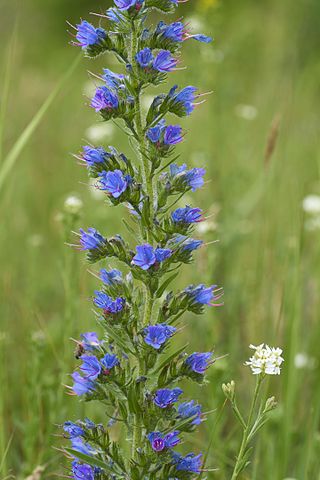
Echium vulgare, known as viper's bugloss and blueweed, is a species of flowering plant in the borage family Boraginaceae. It is native to most of Europe and western and central Asia and it occurs as an introduced species in north-eastern North America, south-western South America and the South and North Island of New Zealand. The plant root was used in ancient times as a treatment for snake or viper bites. If eaten, the plant is toxic to horses and cattle through the accumulation of pyrrolizidine alkaloids in the liver.

Echium is a genus of flowering plants in the family Boraginaceae that contains about 70 species and several subspecies.

The orange swift or orange moth is a moth belonging to the family Hepialidae. The species was first described by Carl Linnaeus in 1761 and was previously placed in the genus Hepialus. It is distributed throughout Europe.
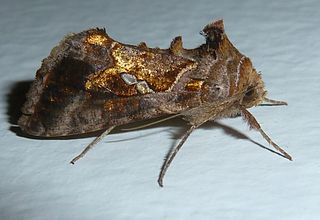
The tomato looper or golden twin-spot moth(Chrysodeixis chalcites) is a moth of the family Noctuidae, subfamily Plusiinae. It mainly lives in southern Europe, the Levant and tropical Africa, but can be seen migrating across much of Europe. In 2013, it was spotted in Canada. It is an important horticultural pest in New Zealand.
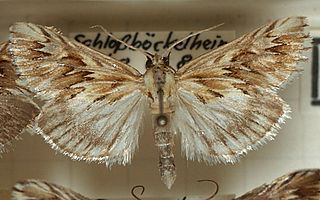
Cynaeda dentalis is a species of moth of the family Crambidae. It is found in Europe, Jordan, Turkey and Cape Verde.

Ethmia terminella is a moth of the family Depressariidae. It was described by Thomas Bainbrigge Fletcher in 1838 and is found in Europe.

Dialectica scalariella is a moth of the family Gracillariidae. It is found from France to the Iberian Peninsula, Italy and the Balkan Peninsula. Recently an imago was found in Great Britain. It was introduced in Australia for the biological control of the weed Echium plantagineum and has since spread to New Zealand.

Actinotia radiosa is a moth in the family Noctuidae. It is found in southern Europe and the southern parts of central Europe, Anotolia, southern Russia, and the Caucasus region. In mountainous areas it is found up to heights of 1,800 m (5,900 ft).

Sideridis lampra is a species of moth of the family Noctuidae. It is found from southern and central Europe, east to the Ural and Altai and in the south to eastern Turkey.
Coleophora tauricella is a moth of the family Coleophoridae. It is found in Croatia and Greece.

Coleophora pennella is a moth of the family Coleophoridae. It is found in most of Europe.
Coleophora gallurella is a moth of the family Coleophoridae. It is found on Sardinia.

Euphyes vestris, the dun skipper, sedge witch or dun sedge skipper, is a species of butterfly of the family Hesperiidae. It is found in North America from Nova Scotia west across southern Canada to southern Alberta, south to Florida, the Gulf Coast and eastern Texas. There are disjunct populations in the High Plains and Rocky Mountains and along the Pacific Coast.

Singularia alternaria is a moth of the family Pterophoridae. It is found in Argentina, Chile and Ecuador.

Synopsia sociaria is a species of moth in the family Geometridae. It is found from the southern part of central Europe to western Central Asia. In the north, the range extends from the North Sea coast to the Baltic region and Russia. In the Caucasus, subspecies S. sociaria unitaria is found.
Ethmia lepidella is a moth in the family Depressariidae. It is found in Algeria, Tunisia, Libya, the Palestinian Territories, the United Arab Emirates, Turkey and Spain.

Epascestria pustulalis is a species of moth in the family Crambidae. It is found in large parts of Europe, except Ireland, Great Britain, Norway, Finland, Denmark, the Benelux, France, Switzerland, Portugal, Slovenia and Croatia. It is also present in the Near East, including Lebanon and Turkey.
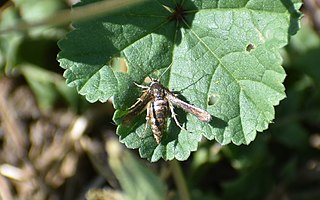
Microsphecia tineiformis is a moth of the family Sesiidae. It is found in southern Europe. It has also been recorded from Morocco, Algeria, Tunisia, Asia Minor, Armenia and from Azerbaijan to northern Iran and northern Iraq.

Tinagma balteolella is a moth in the Douglasiidae family. It is found in Great Britain, France, Belgium, the Netherlands, Germany, Switzerland, Austria, Italy, Spain, the Czech Republic, Slovakia, Croatia, Hungary, Romania, Poland, Lithuania and Ukraine. It is also found in Morocco and Jordan.
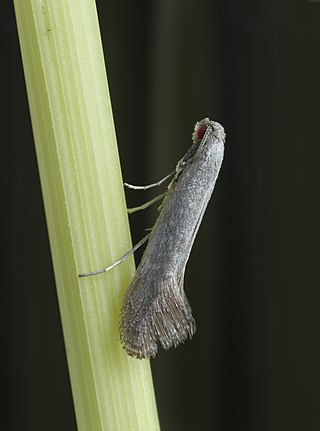
Tinagma ocnerostomellum, the bugloss spear wing, is a moth in the family Douglasiidae. It is found in Great Britain, Portugal, Spain, France, Belgium, the Netherlands, Germany, Denmark, Austria, Switzerland, Italy, the Czech Republic, Slovakia, Poland, Hungary, North Macedonia, Greece, Norway, Sweden, Finland, the Baltic region, Ukraine and on Sicily and Crete.















